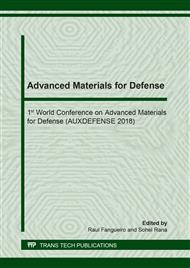[1]
N.T. Tran, T.K. Tran, J.K. Jeon, J.K. Park, D.J. Kim, Fracture energy of ultra-high-performance fiber-reinforced concrete at high strain rates, Cement and Concrete Research. 79 (2016) 169–184.
DOI: 10.1016/j.cemconres.2015.09.011
Google Scholar
[2]
R. Yu, P.R. Spiesz, H.J.H. Brouwers, Development of Ultra-High Performance Fiber Reinforced Concrete (UHPFRC): Towards an efficient utilization of binders and fibers, Construction and Building Materials. 79 (2015) 273–82.
DOI: 10.1016/j.conbuildmat.2015.01.050
Google Scholar
[3]
T. Soetens, A.V. Gysel, S. Mattys, L. Taerwe, A semi-analytical model to predict the pull-out behavior of inclined hooked-end steel fibers, Construction and Building Materials. 43 (2013) 253-265.
DOI: 10.1016/j.conbuildmat.2013.01.034
Google Scholar
[4]
N. Banthia, M. Sappakittipakorn, Toughness enhancement in steel fiber reinforced concrete through fiber hybridization, Cement and Concrete Research. 37 (2007) 1366–1372.
DOI: 10.1016/j.cemconres.2007.05.005
Google Scholar
[5]
N.T. Tran, T.K. Tran, D.J. Kim, High rate response of ultra-high-performance fiber reinforced concretes under direct tension, Cement and Concrete Research, 69 (2015) 72–87.
DOI: 10.1016/j.cemconres.2014.12.008
Google Scholar
[6]
P. Rossi, Influence of fibre geometry and matrix maturity on the mechanical performance of ultra-high-performance cement-based composites, Cement and Concrete Composites, 37 (2013) 246–248.
DOI: 10.1016/j.cemconcomp.2012.08.005
Google Scholar
[7]
Y.S. Tai, S. El-Tawil, T.H. Chung, Performance of deformed steel fibers embedded in ultra-high performance concrete subjected to various pullout rates, Cement and Concrete Research, 89 (2016) 1–13.
DOI: 10.1016/j.cemconres.2016.07.013
Google Scholar
[8]
K. Wille, A.E. Naaman, Bond Stress-Slip Behavior Of Steel Fibers Embedded In Ultra High Performance Concrete, Proceedings of 18th European conference on fracture and damage of advanced fiber-reinforced cement-based materials. (2010) 99–111.
Google Scholar
[9]
S. Abdallah, M.Z. Fan, X.M. Zhou, Pull-Out Behaviour of Hooked-end Steel Fibres Embedded in Ultra-high Performance Mortar with Various W/B Ratios, International Journal of Concrete Structures and Materials. 11 (2017) 301–313.
DOI: 10.1007/s40069-017-0193-8
Google Scholar
[10]
G. Orange, P. Acker, C. Vernet, A new generation of UHP concrete: DUCTAL damage resistance and micromechanical analysis, in proceedings of RILEM- High Performance Fiber Reinforced Cement Composites. (1999) 101-111.
Google Scholar
[11]
P. Robins, S. Austin, P. Jones, Pull-out behaviour of hooked steel fibres, Materials and Structures. 35 (2002) 434-442.
DOI: 10.1007/bf02483148
Google Scholar
[12]
J. Zhang, V.C. Li, Effect of inclination angle on fiber rupture load in fiber reinforced cementitious composites, Composites Science and Technology. 62 (2002) 775-781.
DOI: 10.1016/s0266-3538(02)00045-3
Google Scholar
[13]
S.H. Park, D.J. Kim, G.S. Ryu, K.T. Koh, Tensile behavior of ultra high performance hybrid fiber reinforced concrete, Cement and Concrete Composites. 34 (2012) 172-184.
DOI: 10.1016/j.cemconcomp.2011.09.009
Google Scholar
[14]
Z. Wu, C. Shi, W. He, Effects of steel fiber content and shape on mechanical properties of ultra high performance concrete, Construction and Building Materials. 103 (2016) 8-14.
DOI: 10.1016/j.conbuildmat.2015.11.028
Google Scholar
[15]
D.Y. Yoo, S. Kim, G.J. Park, J.J. Park, S.W. Kim, Effects of fiber shape, aspect ratio, and volume fraction on flexural behavior of ultra-high-performance fiber-reinforced cement composites Composite Structures. 174 (2017) 375-388.
DOI: 10.1016/j.compstruct.2017.04.069
Google Scholar
[16]
M. Xu, B. Hallinan, K. Wille, Effect of loading rates on pullout behavior of high strength steel fibers embedded in ultra-high performance concrete, Cement and Concrete Composites. 49 (2016) 59–69.
DOI: 10.1016/j.cemconcomp.2016.03.014
Google Scholar
[17]
Y.S. Tai, S. El-Tawil, High loading-rate pullout behavior of inclined deformed steel fibers embedded in ultra-high performance concrete, Construction and Building Materials. 148 (2017) 204–218.
DOI: 10.1016/j.conbuildmat.2017.05.018
Google Scholar
[18]
P.P. Li, Q.L. Yu, H.J.H. Brouwers, Effect of coarse basalt aggregates on the properties of Ultra-high Performance Concrete (UHPC), Construction and Building Materials. 170 (2018) 649-659.
DOI: 10.1016/j.conbuildmat.2018.03.109
Google Scholar
[19]
N. Banthia, J.F. Trottier, Concrete reinforced with deformed steel fibers, part I: bond-slip mechanisms, ACI Materials Journal. 91 (1994) 435-446.
DOI: 10.14359/4059
Google Scholar
[20]
V.C. Li, Y. Wang, S. Backer, Effect of inclining angle, bundling and surface treatment on synthetic fibre pull-out from a cement matrix, Composites. 21 (1990) 132-140.
DOI: 10.1016/0010-4361(90)90005-h
Google Scholar


